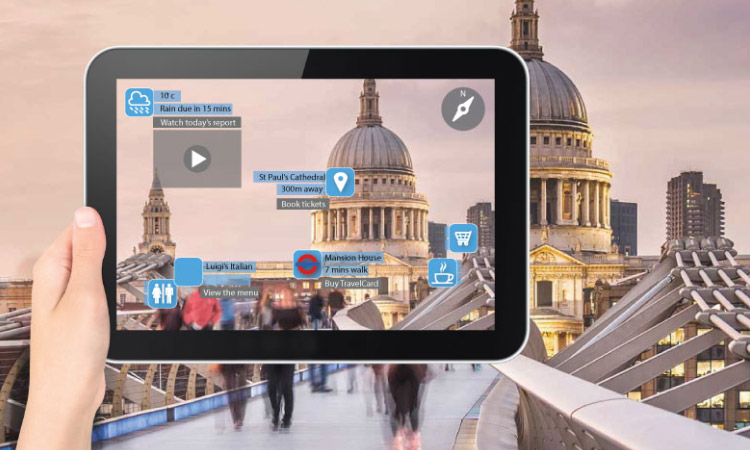Augmented reality is the integration of digital information with the user’s environment in real time. Unlike virtual reality, which is often mentioned in the same breath but creates a totally artificial environment, augmented reality uses the existing environment and overlays new information on top of it.
Augmented reality hardware and applications have more uses in transforming the real world than virtual reality. But there is still much fact vs fiction.
Here are 10 myths vs realities about augmented reality.
MYTHS
- MOST PEOPLE DON’T KNOW WHAT AUGMENTED REALITY IS: Myth. 73% of Americans state they were “knowledgeable” about the Internet of Things (IoT) and AR markets in the 2016 ISACA survey. This represents a big decline from 83% in 2015, suggesting that the IoT and AR markets are becoming more confusing as they expand with more devices.
- IT IS UNCERTAIN WHETHER AUGMENTED REALITY IS FACT OR FAD: Myth. Worldwide augmented reality headset sales could hit $1.2 billion in 2017, The AR market could grow from to $120 billion by 2020.
- AUGMENTED REALITY IS LESS SUSCEPTIBLE TO HACKING: Myth. 77% of respondents in the ISACA survey believe that AR enhancements could make IoT devices more susceptible to data breaches. Events like the Mirai botnet attack, which hijacked IoT devices to shut down major websites, and the surge in data breaches could hurt consumer confidence in the security of their AR hardware and apps.
- BIG TECH GIANTS, LIKE GOOGLE AND MICROSOFT, WILL LEAD THE WAY: Myth. 737 AR start-ups are listed on AngelList, with an average valuation of $4.7 million. The three most followed companies are motion control start-up Leap Motion, healthcare start-up Augmedix, and instant language translation start-up Waygo. The most valuable AR start-up is Magic Leap, which was valued at $4.5 billion in February after raising $793.5 million in Series C funding. The start-up is reportedly developing an AR headset, similar to Microsoft’s HoloLens, which projects holographic images onto real-world surfaces. One top investor is Alphabet’s Google, which previously failed to crack the AR market with the maligned Google Glass.
- AUGMENTED REALITY STILL ISN’T VERY ACCESSIBLE NOW. Myth. Augmented Reality (AR) is easily accessible for anyone who owns a computer with a webcam, camera phone, or game console with a camera. There are 188 virtual reality headsets currently available on Amazon.
REALITIES
- KEY TO SUCCESS LIES IN ITS UTILITY: Reality. Augmented reality is making strides in industries including architecture, marketing, healthcare, military, retail, and tourism. AR enhances the shopping experience by assisting customers finding items in the store, displaying product reviews, and generating 3D models of rooms and furniture making it easier for consumers to visualize. In the tourism industry, augmented reality is optimized to provide additional information on landmarks and museum exhibitions.
- AUGMENTED REALITY GREATLY ENHANCES CUSTOMER EXPERIENCE: Reality. For example, the furniture giant, IKEA, came out with an app a couple of years ago that contains part of their catalogue and AR functionality, While IKEA’s application has a few bugs and needs some updating, it’s definitely a step in the direction we hope others will follow. AR shows great potential to revolutionize the online buying experience
- WITHOUT REAL UTILITY, AN AUGMENTED REALITY APP HAS LIMITED LIFE: Reality. Niantic’s Pokemon Go, which greatly boosted mainstream awareness of augmented reality apps, hit a peak of 45 million daily active users (DAUs) in one month. However, DAUs plunged to 30 million the following month and continued dropping. Pokemon Go was implicated in “hundreds” of crimes, including robberies, thefts, assaults, and driving offenses. These clashes highlight the serious risks of merging digital worlds with real ones. Niantic was sued for turning quiet parks into crowded ones filled with litter.
- MOST PEOPLE BELIEVE AUGMENTED REALITY BENEFITS OUR DAILY LIVES. Reality. 60% to 70% of consumers see clear benefits in using AR and IoT devices in their daily life and at work, according to ISACA. In daily life, 69% believe the tech could help them learn new skills, 62% saw shopping benefits, and 62% see healthcare benefits. At work, 69% see the devices being used for workplace training, 65% think they could be used to improve safety, and 63% think they could be used for product demonstrations. 64% of respondents believe that AR enhancements could improve their workplace by enabling remote participation in meetings.
- MOBILE WILL GREATLY ACCELERATE GROWTH OF AUGMENTED REALITY: Reality. The next iPhone will include hardware-level Augmented Reality. Tim Cook has gone on the record to sing the praises of AR, and Google’s Tango platform and the Lenovo Phab 2 smartphone have already shown how such a system might work. Asus unveiled the ZenFone AR at this year’s CES. The ZenPhone comes loaded with Google’s Tango technology, and Asus CEO Jerry Shin touted the handset in the press, saying, “The ZenFone AR will come with advanced functionality and performance at a competitive price.” Though it’s highly doubtful the ZenFone will displace the iPhone at the top of the smartphone world any time soon, the AR functionality Asus is bringing to market is here to stay, and will be baked in to multiple handsets.
Do these myths vs reality help clear up confusion about augmented reality to you? Could augmented reality be a benefit to your company?

